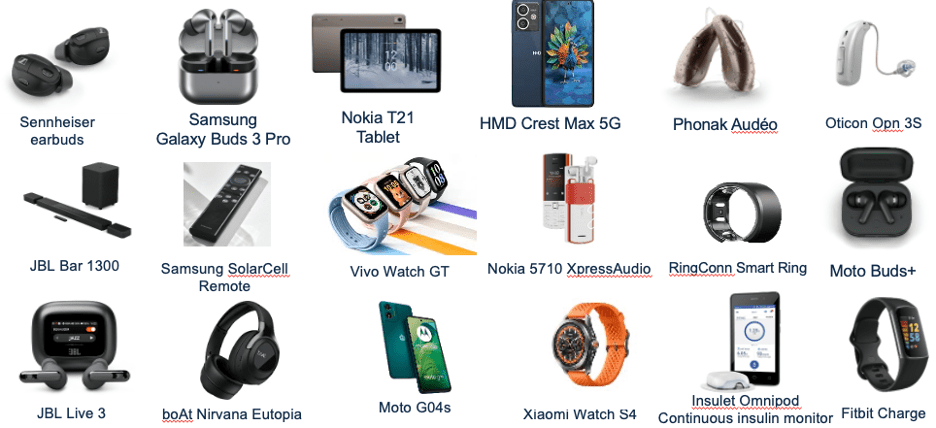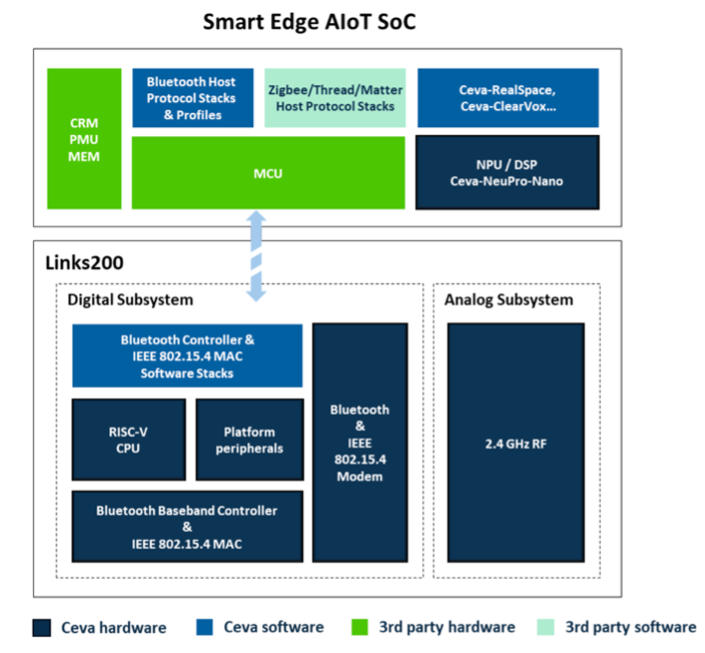Key Takeaways
- Bluetooth SIG continues to innovate, introducing features like Auracast and High Data Throughput for improved audio experiences.
- The Bluetooth and 802.15.4 markets are projected to grow at a CAGR of 7% to 10% through 2029, totaling over $100B annually.
- Ceva's Links200 platform supports advanced Bluetooth capabilities and 802.15.4 compliance, enabling the design of integrated Edge AIoT SoCs.
There is no IoT without wireless. If you have a great idea for a world-beating IoT device, you must integrate a wireless module (Bluetooth, Zigbee, Wi-Fi, UWB…) into that device. A ready-made companion wireless chip connected to MCU is one approach but will significantly increase unit cost and reduce profits. Products in most IoT markets depend on System on Chips (SoC) with embedded wireless to meet cost and low power targets, a high barrier to entry for non-wireless experts. Prepackaged MAC & modem IP addresses part of the problem but not the RF part. Which is why a turnkey solution combining MAC, modem and RF is an important step to unleash a flood of new products from the great majority of potential innovators whose only shortcoming is lack of wireless expertise.

What new products?
If you want to sell billions of products, sell to consumers. It’s a tough market but differentiated products can be very successful. Wireless earbuds provide an obvious example. You might think that market has already been locked down but you’d be wrong. The Bluetooth SIG continues to innovate at a furious pace, now offering Auracast for unprecedented easy audio sharing experience, and introducing soon High Data Throughput (HDT) for even better audio quality with lossless multi-channel capability. Add 3D audio for a more realistic and immersive sound experience. In gaming, low latency improves the gaming experience whether through earbuds or headphones. Consider also that medical, payment, keyless entry, retail, hearing aid, and other applications build on the same low power Bluetooth communications links.
Meanwhile ZigBee, Thread and Matter, all underpinned by IEEE 802.15.4, are central to home automation. ZigBee is already well established for smart lights, smart thermostats and more. Thread and Matter are emerging options to extend interoperability between devices from various ecosystems. A smart home is likely to require support for some if not all these options and there are boundless opportunities to imagine more devices to further enhance convenience around the home.
Together the Bluetooth and 802.15.4 markets account for over $100B per year today and are expected to grow between 7% and 10% CAGR through 2029. This has to be a very appealing target for product builders.
Ceva-Waves Links200
If you have both wearables and home automation, you’re probably controlling them through your phone or tablet, maybe even your watch, all through either Bluetooth or 802.15.4. As a consumer you don’t care about protocols; you just want to turn on a light while listening to a playlist through your wireless earbuds. Which means that the wireless component in some of your devices must support all these options. Such multi-protocol support is not uncommon today, in some cases even adding Wi-Fi, cellular and UWB. Here, let’s focus on Bluetooth and 802.15.4.

Ceva pretty much owns the embedded Bluetooth business, providing solutions for many years and shipping over a billion devices per year. They stay very current with Bluetooth SIG releases, and even provide next generations ahead of official ratifications, now supporting up to Bluetooth 6.0 with LE Audio and Channel Sounding. They were also one of the first providers to qualify for Auracast compatibility. Next generations additions include low latency for gaming, High Data Throughput (HDT) that will more than triple the speed of traditional Bluetooth LE, allowing far better audio quality in Bluetooth LE than in Bluetooth Classic. The Links200 platform supports all of these capabilities, together with Bluetooth 6.0 Channel Sounding for accurate and secure ranging. The platform also provides IEEE 802.15.4 MAC support for ZigBee, Thread and Matter compliance and allows for concurrent multi-link communication through Ceva’s smart coexistence techniques.
All impressive but the big add in my view, to truly make this solution turnkey, is an included RF stage implemented in a TSMC 12nm FFC+ process for lower power, high performance (and low leakage). Equally important, this stage includes a class 1.5 power amplifier. All that is left for the integrator is to connect that output to an antenna. This unique turnkey IP platform is the only solution in the market enabling the design of innovative fully integrated Edge AIoT System on Chip with advanced processing power capability for headsets, earbuds, speakers, smart watches, smart glasses and more.
Integrating Links200
The Links200 IP is delivered with Verilog RTL source files for the digital part, C software source code running on the platform processor, and GDSII for the RF stage, plus a complete software framework to run on a host MCU. It also includes protocol stacks with comprehensive list of profiles to address a broad range of applications.
Ceva optionally supplies several complementary IPs to further enhance functionality, including:
- The NeuPro-Nano, a unique Edge Neural Processor Unit IP that efficiently executes embedded ML workloads for always-on audio, voice, vision, and sensing use cases
- RealSpace, a spatial audio software solution offering 3D audio rendering and low latency head tracking for gaming
- ClearVox, a software solution for noise reduction and keyword spotting
- MotionEngine, software solution for tap, in-ear detection and activity classification
You can read more about the Links200 capability HERE.
Also Read:
Ceva-XC21 and Ceva-XC23 DSPs: Advancing Wireless and Edge AI Processing
AI PC momentum building with business adoption anticipated
Bluetooth 6.0 Channel Sounding is Here
Share this post via:





Comments
There are no comments yet.
You must register or log in to view/post comments.